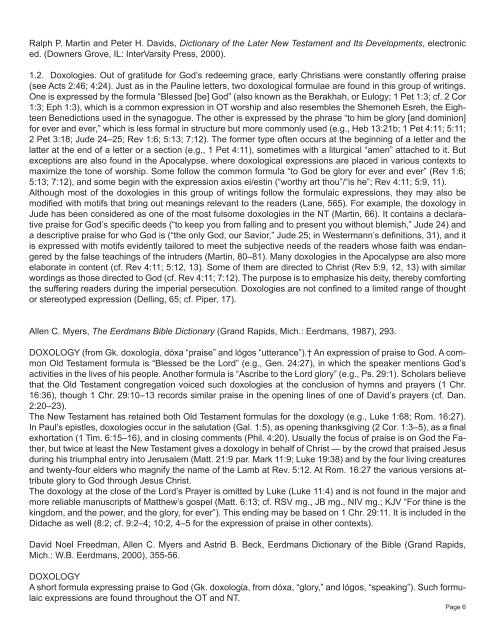Doxologies in the New Testament
Doxologies in the New Testament
Doxologies in the New Testament
You also want an ePaper? Increase the reach of your titles
YUMPU automatically turns print PDFs into web optimized ePapers that Google loves.
Ralph P. Mart<strong>in</strong> and Peter H. Davids, Dictionary of <strong>the</strong> Later <strong>New</strong> <strong>Testament</strong> and Its Developments, electronic<br />
ed. (Downers Grove, IL: InterVarsity Press, 2000).<br />
1.2. <strong>Doxologies</strong>. Out of gratitude for God’s redeem<strong>in</strong>g grace, early Christians were constantly offer<strong>in</strong>g praise<br />
(see Acts 2:46; 4:24). Just as <strong>in</strong> <strong>the</strong> Paul<strong>in</strong>e letters, two doxological formulae are found <strong>in</strong> this group of writ<strong>in</strong>gs.<br />
One is expressed by <strong>the</strong> formula “Blessed [be] God” (also known as <strong>the</strong> Berakhah, or Eulogy; 1 Pet 1:3; cf. 2 Cor<br />
1:3; Eph 1:3), which is a common expression <strong>in</strong> OT worship and also resembles <strong>the</strong> Shemoneh Esreh, <strong>the</strong> Eighteen<br />
Benedictions used <strong>in</strong> <strong>the</strong> synagogue. The o<strong>the</strong>r is expressed by <strong>the</strong> phrase “to him be glory [and dom<strong>in</strong>ion]<br />
for ever and ever,” which is less formal <strong>in</strong> structure but more commonly used (e.g., Heb 13:21b; 1 Pet 4:11; 5:11;<br />
2 Pet 3:18; Jude 24–25; Rev 1:6; 5:13; 7:12). The former type often occurs at <strong>the</strong> beg<strong>in</strong>n<strong>in</strong>g of a letter and <strong>the</strong><br />
latter at <strong>the</strong> end of a letter or a section (e.g., 1 Pet 4:11), sometimes with a liturgical “amen” attached to it. But<br />
exceptions are also found <strong>in</strong> <strong>the</strong> Apocalypse, where doxological expressions are placed <strong>in</strong> various contexts to<br />
maximize <strong>the</strong> tone of worship. Some follow <strong>the</strong> common formula “to God be glory for ever and ever” (Rev 1:6;<br />
5:13; 7:12), and some beg<strong>in</strong> with <strong>the</strong> expression axios ei/est<strong>in</strong> (“worthy art thou”/“is he”; Rev 4:11; 5:9, 11).<br />
Although most of <strong>the</strong> doxologies <strong>in</strong> this group of writ<strong>in</strong>gs follow <strong>the</strong> formulaic expressions, <strong>the</strong>y may also be<br />
modified with motifs that br<strong>in</strong>g out mean<strong>in</strong>gs relevant to <strong>the</strong> readers (Lane, 565). For example, <strong>the</strong> doxology <strong>in</strong><br />
Jude has been considered as one of <strong>the</strong> most fulsome doxologies <strong>in</strong> <strong>the</strong> NT (Mart<strong>in</strong>, 66). It conta<strong>in</strong>s a declarative<br />
praise for God’s specific deeds (“to keep you from fall<strong>in</strong>g and to present you without blemish,” Jude 24) and<br />
a descriptive praise for who God is (“<strong>the</strong> only God, our Savior,” Jude 25; <strong>in</strong> Westermann’s def<strong>in</strong>itions, 31), and it<br />
is expressed with motifs evidently tailored to meet <strong>the</strong> subjective needs of <strong>the</strong> readers whose faith was endangered<br />
by <strong>the</strong> false teach<strong>in</strong>gs of <strong>the</strong> <strong>in</strong>truders (Mart<strong>in</strong>, 80–81). Many doxologies <strong>in</strong> <strong>the</strong> Apocalypse are also more<br />
elaborate <strong>in</strong> content (cf. Rev 4:11; 5:12, 13). Some of <strong>the</strong>m are directed to Christ (Rev 5:9, 12, 13) with similar<br />
word<strong>in</strong>gs as those directed to God (cf. Rev 4:11; 7:12). The purpose is to emphasize his deity, <strong>the</strong>reby comfort<strong>in</strong>g<br />
<strong>the</strong> suffer<strong>in</strong>g readers dur<strong>in</strong>g <strong>the</strong> imperial persecution. <strong>Doxologies</strong> are not conf<strong>in</strong>ed to a limited range of thought<br />
or stereotyped expression (Dell<strong>in</strong>g, 65; cf. Piper, 17).<br />
Allen C. Myers, The Eerdmans Bible Dictionary (Grand Rapids, Mich.: Eerdmans, 1987), 293.<br />
DOXOLOGY (from Gk. doxología, dóxa “praise” and lógos “utterance”).† An expression of praise to God. A common<br />
Old <strong>Testament</strong> formula is “Blessed be <strong>the</strong> Lord” (e.g., Gen. 24:27), <strong>in</strong> which <strong>the</strong> speaker mentions God’s<br />
activities <strong>in</strong> <strong>the</strong> lives of his people. Ano<strong>the</strong>r formula is “Ascribe to <strong>the</strong> Lord glory” (e.g., Ps. 29:1). Scholars believe<br />
that <strong>the</strong> Old <strong>Testament</strong> congregation voiced such doxologies at <strong>the</strong> conclusion of hymns and prayers (1 Chr.<br />
16:36), though 1 Chr. 29:10–13 records similar praise <strong>in</strong> <strong>the</strong> open<strong>in</strong>g l<strong>in</strong>es of one of David’s prayers (cf. Dan.<br />
2:20–23).<br />
The <strong>New</strong> <strong>Testament</strong> has reta<strong>in</strong>ed both Old <strong>Testament</strong> formulas for <strong>the</strong> doxology (e.g., Luke 1:68; Rom. 16:27).<br />
In Paul’s epistles, doxologies occur <strong>in</strong> <strong>the</strong> salutation (Gal. 1:5), as open<strong>in</strong>g thanksgiv<strong>in</strong>g (2 Cor. 1:3–5), as a f<strong>in</strong>al<br />
exhortation (1 Tim. 6:15–16), and <strong>in</strong> clos<strong>in</strong>g comments (Phil. 4:20). Usually <strong>the</strong> focus of praise is on God <strong>the</strong> Fa<strong>the</strong>r,<br />
but twice at least <strong>the</strong> <strong>New</strong> <strong>Testament</strong> gives a doxology <strong>in</strong> behalf of Christ — by <strong>the</strong> crowd that praised Jesus<br />
dur<strong>in</strong>g his triumphal entry <strong>in</strong>to Jerusalem (Matt. 21:9 par. Mark 11:9; Luke 19:38) and by <strong>the</strong> four liv<strong>in</strong>g creatures<br />
and twenty-four elders who magnify <strong>the</strong> name of <strong>the</strong> Lamb at Rev. 5:12. At Rom. 16:27 <strong>the</strong> various versions attribute<br />
glory to God through Jesus Christ.<br />
The doxology at <strong>the</strong> close of <strong>the</strong> Lord’s Prayer is omitted by Luke (Luke 11:4) and is not found <strong>in</strong> <strong>the</strong> major and<br />
more reliable manuscripts of Mat<strong>the</strong>w’s gospel (Matt. 6:13; cf. RSV mg., JB mg., NIV mg.; KJV “For th<strong>in</strong>e is <strong>the</strong><br />
k<strong>in</strong>gdom, and <strong>the</strong> power, and <strong>the</strong> glory, for ever”). This end<strong>in</strong>g may be based on 1 Chr. 29:11. It is <strong>in</strong>cluded <strong>in</strong> <strong>the</strong><br />
Didache as well (8:2; cf. 9:2–4; 10:2, 4–5 for <strong>the</strong> expression of praise <strong>in</strong> o<strong>the</strong>r contexts).<br />
David Noel Freedman, Allen C. Myers and Astrid B. Beck, Eerdmans Dictionary of <strong>the</strong> Bible (Grand Rapids,<br />
Mich.: W.B. Eerdmans, 2000), 355-56.<br />
DOXOLOGY<br />
A short formula express<strong>in</strong>g praise to God (Gk. doxologɩá, from dóxa, “glory,” and lógos, “speak<strong>in</strong>g”). Such formulaic<br />
expressions are found throughout <strong>the</strong> OT and NT.<br />
Page 6

















